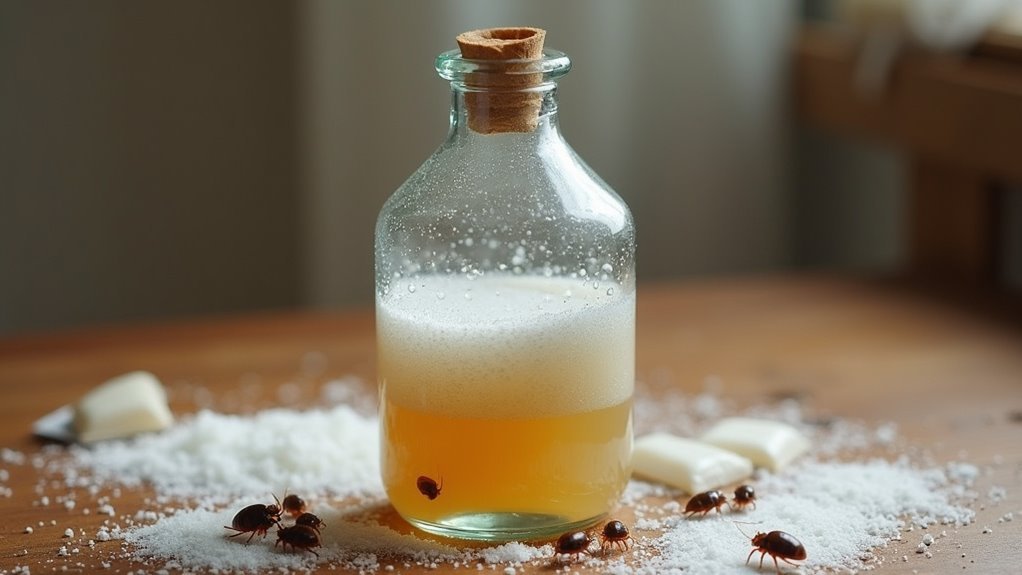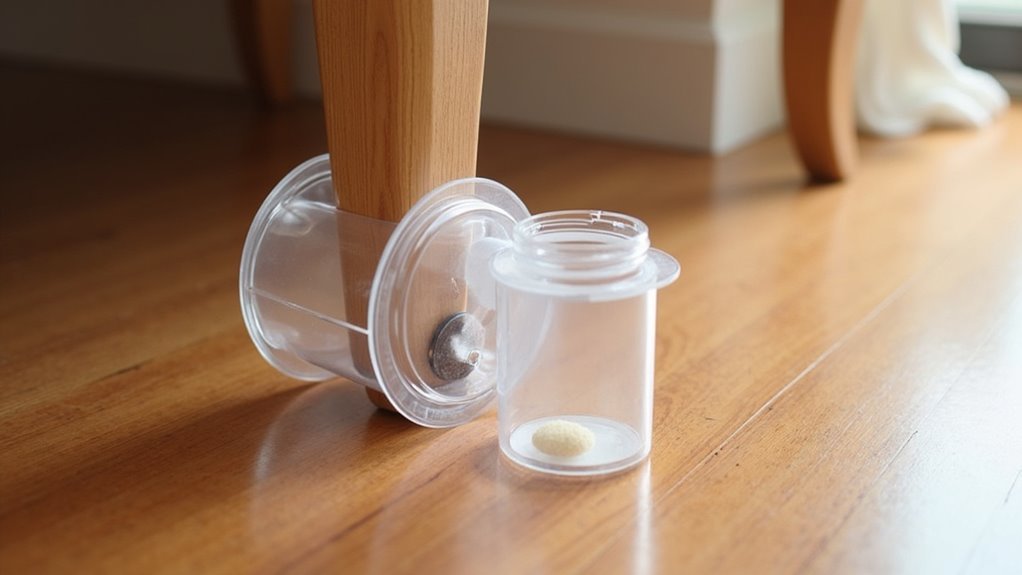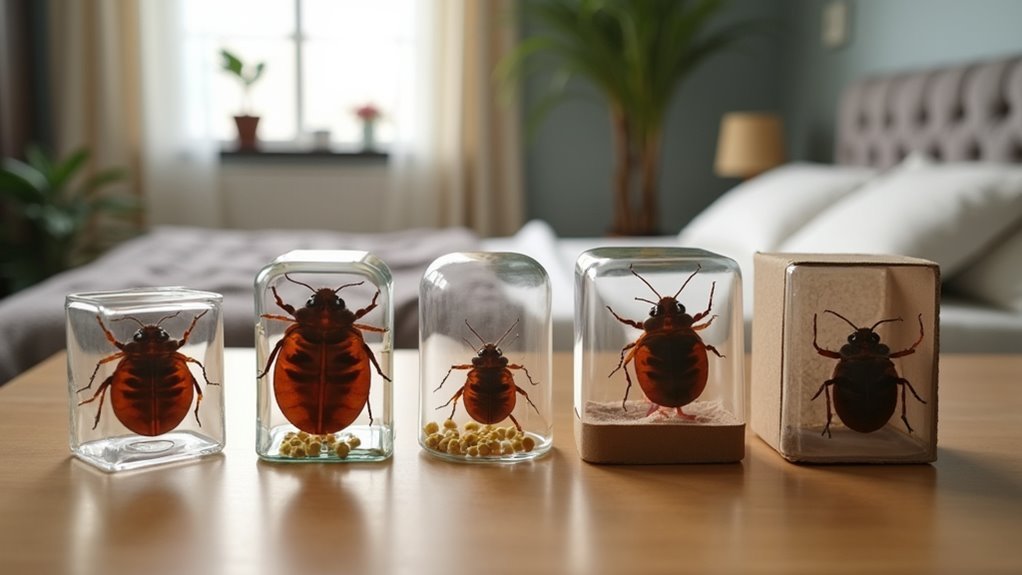You can build five effective DIY bed bug detection traps using household items for under $10. Create a sugar and yeast CO2 bottle trap using a 2-liter bottle to attract bugs with fermentation gases. Set up interceptor bowl traps with talcum powder around furniture legs. Build two-container furniture leg interceptors with rough entry surfaces and smooth escape-proof walls. Construct paper towel climbing traps near beds, or deploy dark bowl detection stations with fermenting sugar solutions to discover these details and implementation steps.
Sugar and Yeast CO2 Bottle Trap

One of the most effective DIY bed bug detection methods involves creating a simple CO2 trap using common household items.
You’ll need a 2-3 liter bottle, 2 cups of granulated sugar, yeast, and warm water. Cut off the bottle’s top, then wrap the remaining base with paper towels for texture.
Mix the sugar and yeast with warm water to create a fermentation solution that produces carbon dioxide. Invert the cut top into the bottle’s base after adding your mixture.
Bed bugs are naturally attracted to carbon dioxide because it mimics human breath, making this trap highly effective for detection.
Once inside, they can’t escape due to the smooth plastic surfaces, allowing you to identify infestations early.
Interceptor Bowl Trap With Talcum Powder
While the CO2 trap excels at detection, interceptor bowl traps offer a different approach that’s equally effective and even simpler to construct.
Interceptor bowl traps provide an equally effective yet simpler alternative to CO2 detection methods for bed bug monitoring.
This interceptor trap uses two containers – place a smaller bowl inside a larger one, creating smooth-walled barriers that prevent escape. Apply talcum powder to interior surfaces, making climbing impossible once bed bugs fall in.
The trap mimics attractive conditions while ensuring bugs have become trapped permanently. You can build this bed bug trap using household items, making it extremely cost-effective.
Position traps strategically around your bed and furniture legs to detect bed bugs during early stages of infestation. Regular monitoring provides critical activity information, allowing you to take swift action against potential problems before they escalate into major infestations.
Two-Container Furniture Leg Interceptor

The Two-Container Furniture Leg Interceptor transforms ordinary household containers into an effective barrier system that prevents bed bugs from reaching your sleeping and seating areas. You’ll place a smaller container inside a larger one, positioning this trap under your bed and furniture legs for peak pest control.
| Component | Function |
|---|---|
| Inner Container | Rough-surfaced tape lining allows easy bed bug entry |
| Outer Container | Smooth walls trap bugs, preventing escape |
| Baby Powder/Polish | Creates slippery surface for enhanced effectiveness |
| Regular Maintenance | Monitor captures to assess bed bug problem severity |
These traps catch bed bugs attempting to climb furniture, providing early detection of infestations. The rough interior welcomes bugs while smooth outer walls guarantee they can’t escape, making this an essential addition to your bed bug traps arsenal.
Paper Towel Climbing Trap
Building on container-based interception methods, you can construct an equally effective paper towel climbing trap using a modified plastic bottle that exploits bed bugs’ natural climbing behavior.
This affordable alternative to commercial Bug Traps works because bed bugs are attracted to carbon dioxide emissions from your sugar-yeast bait mixture.
Here’s how these traps catch bugs effectively:
- Bottle preparation: Cut off the top of a 2-3 liter bottle and wrap paper towels around the exterior for climbing grip.
- Bait creation: Add sugar and yeast solution inside to generate CO2 attraction.
- Strategic placement: Position near beds or furniture where bugs emerge from cracks or crevices.
The smooth interior surface prevents escape once bugs climb inside.
This method can help prevent bed bugs from establishing larger populations through early detection.
Dark Bowl Detection Station

Since bed bugs gravitate toward dark surfaces and carbon dioxide sources, you can exploit both preferences by creating a simple dark bowl detection station that doubles as an early warning system.
Mix 10 tablespoons of sugar, 2 tablespoons of yeast, and 1.5 quarts of water in a black bowl. The fermenting mixture produces carbon dioxide that’ll attract bed bugs, mimicking human breath patterns they naturally seek.
Place your trap in suspected areas where bed bugs might hide or travel. The dark surface draws them closer while the CO2 lures them into the bowl, where they’ll become trapped and can’t escape.
This DIY method provides cost-effective early detection before infestations spiral out of control, making it an excellent alternative to expensive commercial traps.
Frequently Asked Questions
How to Lure Bed Bugs Into a Trap?
You’ll attract bed bugs by creating a sugar and yeast solution that ferments and releases carbon dioxide, mimicking human breath. Place this mixture in dark-colored bowls near furniture legs where they travel.
What Can I Use to Draw Bed Bugs Out of Hiding?
You can draw bed bugs out using a sugar-yeast-water mixture that produces carbon dioxide, mimicking human breathing. Place this solution in dark containers near walls or furniture where they’re likely hiding.
Which Bed Bug Traps Actually Work?
You’ll find CO2 traps and interception devices like Climbup Interceptors work best for detection. DIY sugar-yeast traps effectively mimic human breath, while pheromone traps aid early detection, though they won’t eliminate entire infestations.
How to Set a Trap to See if You Have Bed Bugs?
You’ll mix two cups sugar with two liters warm water and yeast in a cut plastic bottle wrapped with paper towels. Place it where you suspect activity and check regularly for trapped bugs.
In Summary
You’ve now got five effective DIY bedbug detection traps that’ll help you catch these pests early. Don’t wait until you’re dealing with a full infestation – set up these traps around your bedroom and furniture legs tonight. Check them regularly, and if you find any bedbugs, you’ll know it’s time to take immediate action. Early detection saves you time, money, and countless sleepless nights dealing with these unwanted visitors.





Leave a Reply